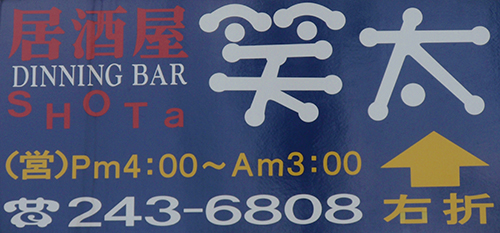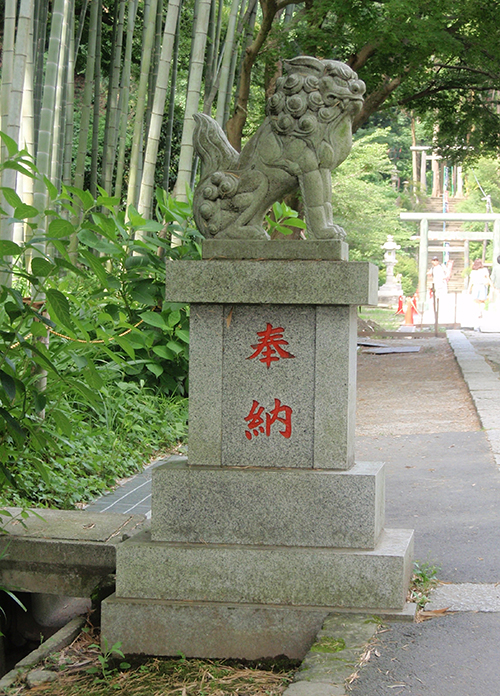37. The "Big" Radical: 大
Coyotes have moved into neighborhoods in my area. People say that if you encounter one of these animals, you can protect yourself by looking as big as possible. It turns out that that's also the idea behind this pictograph:
大 (53: big; general, very; university)
Henshall (the source of all etymologies in this Radical Note) says that 大 is a pictograph of a "person standing with arms and legs spread out to look as large as possible." Did they have coyotes in ancient China?!
This shape is not only a kanji but also radical 37, the "big" radical. And 大 is the on-duty radical in the kanji 大 itself, as well as in 15 other Joyo kanji.
Photo Credit: Eve Kushner
The name 大和 (やまと) represents the name of both an old province (corresponding to what is now Nara Prefecture) and ancient Japan as a whole. This lantern hung outside a hardware store on Sado Island in Niigata Prefecture, which is quite far from Nara, so I think 大和屋 must mean "Japan Shop." Ah, but a Google search reveals that in this case, the yomi is だいわや!
What Is the 大 Radical Called?
The 大 radical often "sits" on the "baseline" of a kanji and occupies much of that character, as in these examples:
天 (58: sky, heavens; weather; nature; top; Uranus)
太 (164: thick; large; great)
央 (429: center)
失 (501: to lose; mistake)
夫 (573: husband; male worker; man)
奥 (1038: deep part; wife)
When the radical is in that position, we can call it だい. That yomi comes from ダイ, one of the two Joyo on-yomi of the 大 kanji (the other being タイ).

Photo Credit: Eve Kushner
I love the look of the two white kanji, which combine to form the name 笑太 (しょうた: a given male name). They feel cheerful and somehow remind me of inflated balloons. Best of all, both contain instances of 大. As we've just seen, our radical is on duty in 太 (164: thick; large; great).
In 笑 (900: to laugh), by contrast, the "bamboo" radical 竹 is on duty. Henshall says that the 大 component on the bottom means "person with a bowed head."
Typically, the Japanese render the name しょうた as 翔太 (in which 翔 is non-Joyo) or 将太. Perhaps it's wordplay to use 笑 instead. My take is that if you go into this izakaya (居酒屋, いざかや: pub), you'll laugh (笑) and get fat (太)!
When the 大 Radical Tops Off a Kanji
The on-duty 大 radical rises to the top in these kanji:
奮 (966: to rouse; energetically)
奇 (1123: extraordinary; odd number)
奪 (1561: to seize)
奉 (1793: to offer; dedicate; revere nominally)
奔 (1825: rush)
奈 (2085: ナ sound)
When the radical is in that upper position, we can call it だいかしら or だいかんむり. As explained in Radical Terms (go to the section "Radical Positions" and look at "Positions 3–4"), かしら (頭) corresponds to "head," and かんむり (冠) means "crown."
For some strange reason, most of the kanji in this second group are less common than those in the first group. I have absolutely no idea why the 大 would sit atop less popular kanji. It must be a fluke.
Photo Credit: Eve Kushner
On the island of Moorea (near Tahiti, in French Polynesia), this local has tattooed three Chinese characters into her neck, including 奥 (1038: deep part; wife). In 2010 she traveled to Shanghai for the World's Fair and became intrigued by Chinese culture.

Photo Credit: Eve Kushner
At Kenchoji, a temple in Kamakura (south of Tokyo), the inscription 奉納 (ほうのう: dedication; offering; presentation) pops up all over the place. The word starts with 奉 (1793: to offer; dedicate; revere nominally), with the 大 radical at the top (though it's a bit hard to recognize).
What Is Big in These Kanji?
The sky is bigger than any human can conceive of, so is that why the 大 radical is in 天? And what part of a 夫 (husband) is purported to be big?! Let's see what Henshall says about the 大 radical in a handful of kanji:
天 (58: sky, heavens; weather; nature; top; Uranus)
In this character, the 大 shape means "person." The stroke above that is an "exaggerated head," symbolizing "uppermost" or "upper part." By association, 天 came to mean "that up above."
太 (164: thick; large; great)
The shape has been simplified over the years, but originally the character contained two instances of 大 for emphasis. As such, the character meant "very big."
夫 (573: husband; male worker; man)
The character initially depicted a "big (i.e., adult) male" (大) with an ornamental "hairpin" (the topmost 一) through his hair, the hairpin indicating "adulthood" in ancient China.
奔 (1825: rush)
Instead of the neatly nested strokes under 大, there was once a pyramid of three 止 shapes. The 大 depicted a “person with legs apart to indicate running while waving arms,” and each 止 represented “foot,” says Henshall in his newer edition. The 止s were then replaced by 卉 (vegetation, grass), which acted phonetically to express “hurry.” Either way, the whole character meant “run fast.”
As these examples show, 大 can represent not only "big" but also "person," as was true in the etymology of the kanji 大 (53).
Photo Credit: Eve Kushner
At a Tokyo temple we find these kanji over the door, from right to left:
辨財天 (べんざいてん: name of the goddess of everything that flows—namely, water, words, music, and knowledge)
尊 (そん: honorific title for Buddhist deities)
This goddess certainly has a range of things in her purview!
The non-Joyo kanji 辨 is an old form of 弁. Today, most people write the name べんざいてん as 弁財天. However, the Japanese often refer to this goddess simply as 弁天 (べんてん).
This temple is in Inokashira (井の頭) Park. Those characters appear at the top of the sign, but in place of の we see the non-Joyo 之. That’s the kanji rendering of the possessive の. If 頭 (かしら) seems familiar, that's because we saw it in だいかしら, the name of the 大 radical when it's atop kanji!
